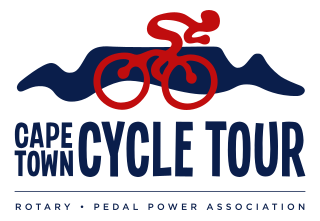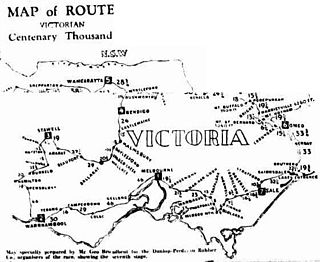Related Research Articles

The Falls Creek Alpine Resort is an alpine ski resort in the Hume region in northeastern Victoria, Australia. It is located in the Alpine National Park in the Victorian Alps, approximately 350 kilometres by road from Melbourne, with the nearest town being Mount Beauty, which is approximately 30 km (20 mi) away. The resort lies between an elevation of 1,500 and 1,830 m above sea level, with the highest lifted point at 1,780 m (5,840 ft). Skiing is possible on the nearby peak of Mount McKay at 1,842 m (6,043 ft), accessed by snowcat from the resort.
London to Brighton refers to a variety of races, tours, charity bicycle rides and rallies that take place between London and Brighton in the United Kingdom.

Bicycle Network is an Australian charity, one of the largest cycling membership organisations in the world, whose mission is to have More People Cycling More Often. Before 2011 it was known as Bicycle Victoria.

Bright is a town in northeastern Victoria, Australia, 319 metres above sea level at the southeastern end of the Ovens Valley. At the 2021 census, Bright had a population of 2,620. It is located in the Alpine Shire local government area.

Road bicycle racing is the cycle sport discipline of road cycling, held primarily on paved roads. Road racing is the most popular professional form of bicycle racing, in terms of numbers of competitors, events and spectators. The two most common competition formats are mass start events, where riders start simultaneously and race to a set finish point; and time trials, where individual riders or teams race a course alone against the clock. Stage races or "tours" take multiple days, and consist of several mass-start or time-trial stages ridden consecutively.

A cyclosportive, or often simply sportive, is a short to long distance, organised, mass-participation cycling event, typically held annually. The Italian term Gran Fondo is commonly used for these events in the United States, Australia and some other English-speaking countries.

This is a glossary of terms and jargon used in cycling, mountain biking, and cycle sport.
Randonneuring is a long-distance cycling sport with its origins in audax cycling. In randonneuring, riders attempt courses of 200 km or more, passing through predetermined "controls" (checkpoints) every few tens of kilometres. Riders aim to complete the course within specified time limits, and receive equal recognition regardless of their finishing order. Riders may travel in groups or alone as they wish, and are expected to be self-sufficient between controls. A randonneuring event is called a randonnée or brevet, and a rider who has completed a 200 km event is called a randonneur. The international governing body for randonneuring is Audax Club Parisien (ACP), which works with other randonneuring organisations worldwide through Les Randonneurs Mondiaux (RM). Randonneuring is popular in France, and has a following in the Netherlands, Belgium, the United Kingdom, Italy, Australia, the United States, Canada, Brazil, Ireland, India, Indonesia, Korea, Japan and Malaysia.

Around the Bay in a Day is a non-competitive fully supported recreational cycling fundraising event organised by Bicycle Network in Victoria, Australia. Cyclists register to ride a course which is 210 km (130 mi) either clockwise or anti-clockwise around Port Phillip Bay, starting and ending in Melbourne, though other distances, both shorter and longer, are available.

The Bogong High Plains, part of the Victorian Alps of the Great Dividing Range, are a section of plains located in the Alpine National Park in the Australian state of Victoria and are situated south of Mount Bogong.

The Cape Town Cycle Tour, formerly known as the Cape Argus Cycle Tour, is an annual cycle race hosted in Cape Town, South Africa, usually 109 km (68 mi) long. It is the first event outside Europe to be included in the Union Cycliste Internationale's Golden Bike Series. South Africa hosts some of the largest, by the number of entrants, sporting events in the world with three being the largest of their type. The Cape Town Cycle Tour, with as many as 35 000 cyclists taking part, is the world's largest individually timed cycle race. The other two are the world's largest ultra-marathon running event, the Comrades Marathon, and the world's largest open water swim, the Midmar Mile.
The Alpine Classic was an Australian bicycle event run every Australia Day weekend in Bright, Victoria. The decision was made to permanently cancel the event as it was being run at a loss. The event is currently managed by O2 Events, having previously been organised by Audax Australia volunteers. Arguably the most difficult single day cycle event in Australia with the 200 km version covering four steep climbs. All distances start at Howitt Park in Bright and are on open roads.

The Maratona dles Dolomites, is an annual single-day road bicycle race covering seven mountain passes in the Dolomites. Open to amateur cyclists, the Maratona—with 9,000 riders from over 70 nations—is one of the biggest Italian Granfondo bicycle races. National Geographic described it as "one of the biggest, most passionate, and most chaotic bike races on Earth."

A century ride is a road cycling ride of 100 kilometers or more in metric system countries or 100 miles or more in imperial system countries, usually as a cycling club-sponsored event. Many cycling clubs sponsor an annual century ride as both a social event for cyclists and as a fund-raiser for the club’s other activities.

Mountain biking in Australia is a mix of dedicated mountain bike parks, ski resorts with mountain bike facilities, and other parks that have become popular with mountain bikers despite lacking dedicated facilities. The peak body for the sport is Mountain Bike Australia (MTBA).

The Centenary 1000 cycling race was a one-week road bicycle race over seven stages covering 1,102 miles (1,773 km). The race was run in 1934 as part of the celebrations of the Centenary of Victoria. The race was originally conceived along the lines of the Dunlop Grand Prix, won by Hubert Opperman then aged 23, by 1h 20' and the concept for the race was covering 1,000 miles (1,600 km) with prizes exceeding £1,000, including a climb over Mount Hotham.
Everesting is an activity in which cyclists or runners ascend and descend a given hill multiple times, in order to have cumulatively climbed 8,848 metres (29,029 ft).
The definition of ultra-distance cycling is far more vague than in ultra running or in ultra-triathlon. Any bike race or ride longer than a century ride, which is 100 miles (160 km), is sometimes considered to be ultra-distance cycling. However, such events are relatively common, so using a longer distance to define the category is more useful, such as any race or ride that is longer than 200 kilometres (120 mi), 300 kilometres (190 mi) or even a double century, 200 miles (320 km).
The IncaDivide Race is a yearly, self-supported, ultra-distance cycling race across the territory of the Incas in South America and organized by the french organization BikingMan. The first edition took the participants through Ecuador and Peru in 2017. This is the first self-supported race to take place in South America. The inaugural edition route was about 3,500 kilometres (2,200 mi) long and went along some sections of the Qhapaq ñan, the legendary inca road network that was built by the Inca civilization. The main challenge of the race lies in its high altitude route and the challenging weather conditions of the Andes. All cyclists have to cycle across the Andes Cordillera with high passes above 4,000 metres (13,000 ft) on remote andean tracks and random road conditions. The inaugural race was held the 1st of July 2017. 17 athletes attempted to complete it but only 6 could reach the finish line. The fastest rider took less than 17 days to cycle from Quito to Cuzco.

Cycling in Canberra, the capital city of Australia, is a popular means of transportation, sporting and recreational pass time. Commuting in the city is supported by an extensive network of urban cycleways and on-street bicycle lanes. As a city established in the 20th century, Canberra's development was heavily influenced by the automobile for much of its history. The popularity of cycling in the city has increased dramatically in the 21st century with growing awareness of environmental issues, government policy supporting active transport and investment in cycling infrastructure. This has led to the development of a strong cycling culture.
References
- ↑ Dyball, Ben. "The Three Peaks". Strava. Retrieved 11 March 2024.
- ↑ O'Brien, Mark. "Three Peaks". Strava. Retrieved 11 March 2024.
- ↑ "Peaks Challenge Falls Creek Turns 10". la velocita. 6 September 2018. Retrieved 26 July 2022.
- ↑ "2011 3 Peaks Challenge". myraceresult. Retrieved 26 July 2022.
- ↑ "2012 3 Peaks Challenge Results". myraceresults. Retrieved 21 July 2022.
- ↑ "2012 3 Peaks Challenge Results". myraceresults. Retrieved 21 July 2022.
- ↑ "SCODY 3 Peaks Challenge 2013 Results". myraceresult. Retrieved 21 July 2022.
- ↑ "SCODY 3 Peaks Challenge 2014 Results". myraceresult. Retrieved 22 July 2022.
- ↑ "Bicycle Network - 2015 Annual Review" (PDF). Bicycle Network. Retrieved 23 July 2022.
- ↑ "Peaks Challenge 2015: Conquered". rideon magazine. Retrieved 23 July 2022.
- ↑ "Highlights from Peaks Challenge Falls Creek 2016". YouTube. Retrieved 25 July 2022.
- ↑ "Taryn Heather - 3 Peaks". specialized. Retrieved 15 September 2022.
- ↑ "Peaks Challenge Falls Creek - The Legend". Bicycle Network. 3 September 2018. Retrieved 15 September 2022.
- ↑ "LATEST NEWS THE AUSTRALIAN EPIC 235KM PEAKS CHALLENGE – FULL RESULTS". granfondodailynews. 9 March 2020. Retrieved 4 August 2022.
- ↑ "LATEST NEWS KING AND QUEEN OF THE PEAKS CROWNED AT PEAKS CHALLENGE 2021 – FULL RESULTS". granfondodailynews. 7 March 2021. Retrieved 15 August 2022.
- ↑ "Top 10 Best Sportives And Gran Fondos To Cycle In The World - Global Cycling Network". Global Cycling Network. Retrieved 14 April 2021.